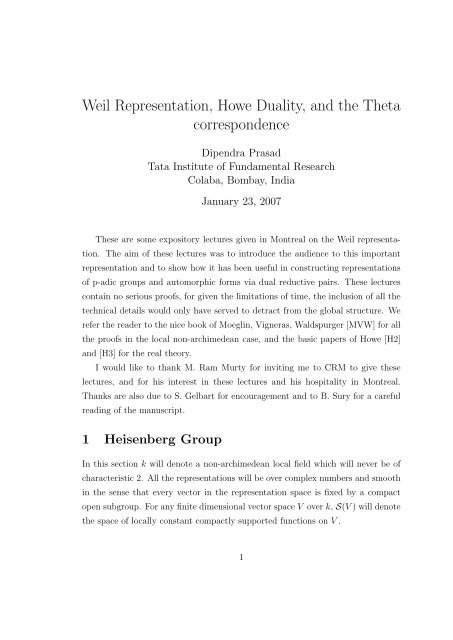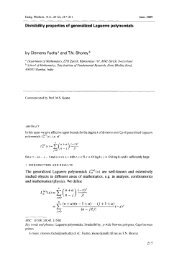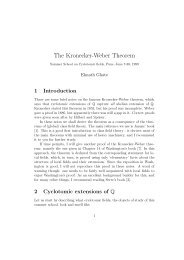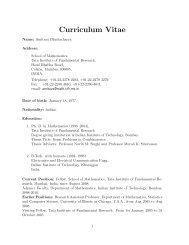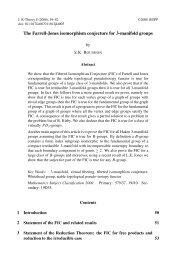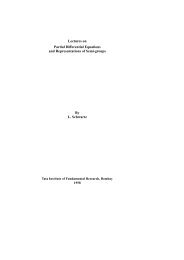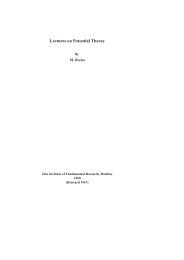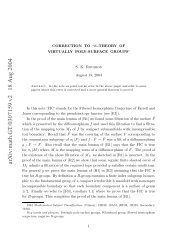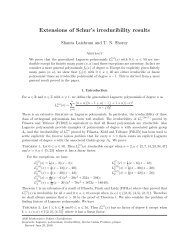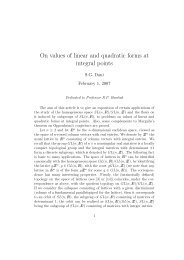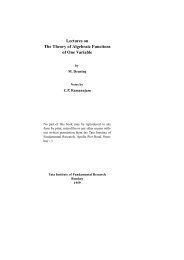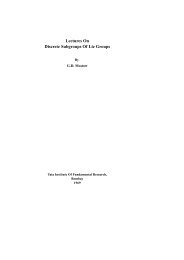Weil Representation, Howe Duality, and the Theta correspondence
Weil Representation, Howe Duality, and the Theta correspondence
Weil Representation, Howe Duality, and the Theta correspondence
Create successful ePaper yourself
Turn your PDF publications into a flip-book with our unique Google optimized e-Paper software.
<strong>Weil</strong> <strong>Representation</strong>, <strong>Howe</strong> <strong>Duality</strong>, <strong>and</strong> <strong>the</strong> <strong>Theta</strong><strong>correspondence</strong>Dipendra PrasadTata Institute of Fundamental ResearchColaba, Bombay, IndiaJanuary 23, 2007These are some expository lectures given in Montreal on <strong>the</strong> <strong>Weil</strong> representation.The aim of <strong>the</strong>se lectures was to introduce <strong>the</strong> audience to this importantrepresentation <strong>and</strong> to show how it has been useful in constructing representationsof p-adic groups <strong>and</strong> automorphic forms via dual reductive pairs. These lecturescontain no serious proofs, for given <strong>the</strong> limitations of time, <strong>the</strong> inclusion of all <strong>the</strong>technical details would only have served to detract from <strong>the</strong> global structure. Werefer <strong>the</strong> reader to <strong>the</strong> nice book of Moeglin, Vigneras, Waldspurger [MVW] for all<strong>the</strong> proofs in <strong>the</strong> local non-archimedean case, <strong>and</strong> <strong>the</strong> basic papers of <strong>Howe</strong> [H2]<strong>and</strong> [H3] for <strong>the</strong> real <strong>the</strong>ory.I would like to thank M. Ram Murty for inviting me to CRM to give <strong>the</strong>selectures, <strong>and</strong> for his interest in <strong>the</strong>se lectures <strong>and</strong> his hospitality in Montreal.Thanks are also due to S. Gelbart for encouragement <strong>and</strong> to B. Sury for a carefulreading of <strong>the</strong> manuscript.1 Heisenberg GroupIn this section k will denote a non-archimedean local field which will never be ofcharacteristic 2. All <strong>the</strong> representations will be over complex numbers <strong>and</strong> smoothin <strong>the</strong> sense that every vector in <strong>the</strong> representation space is fixed by a compactopen subgroup. For any finite dimensional vector space V over k, S(V ) will denote<strong>the</strong> space of locally constant compactly supported functions on V .1
Let W be a finite dimensional vector space over k with a non-degenerate alternatingform . Such a vector space will be called a symplectic space. Itsdimension is even <strong>and</strong> we denote it by 2n. The Heisenberg group H(W ) associatedto <strong>the</strong> symplectic space W is a non-trivial central extension of W by k <strong>and</strong> isdefined to be <strong>the</strong> group of pairswith <strong>the</strong> law of multiplication{(w, t)|w ∈ W, t ∈ k},(w 1 , t 1 )(w 2 , t 2 ) = (w 1 + w 2 , t 1 + t 2 + 1 2 < w 1, w 2 >)The Heisenberg group H(W) clearly sits in <strong>the</strong> exact sequence0 → k → H(W ) → W → 0.The commutator subgroup of H(W ) is k <strong>and</strong> all <strong>the</strong> one dimensional representationsof H(W ) factor through W . We construct below an infinite dimensionalsmooth representation of H(W ). For this fix a decomposition of W as W = W 1 ⊕W 2where W 1 <strong>and</strong> W 2 are maximal totally isotropic subspaces of W (ie, subspaces onwhich <strong>the</strong> alternating form is identically zero). Such a decomposition will be calleda complete polarisation of W .The representation depends on <strong>the</strong> choice of anadditive character ψ of k which will be fixed in all <strong>the</strong>se lectures.Define <strong>the</strong> representation ρ ψ of <strong>the</strong> Heisenberg group H(W ) on S(W 1 ) as follows:ρ ψ (w 1 )f(x) = f(x + w 1 ) for all x, w 1 ∈ W 1 ,ρ ψ (w 2 )f(x) = ψ(< x, w 2 >)f(x) for all x ∈ W 1 , w 2 ∈ W 2ρ ψ (t)f(x) = ψ(t)f(x) for all t ∈ k, x ∈ W 1 .It can be easily checked that this gives a smooth representation of H(W ). Thisrepresentation of H(W ) is called <strong>the</strong> Schrödinger representation.Remark 1.1: If ¯ψ denotes <strong>the</strong> character ¯ψ(x) = ψ(−x), <strong>the</strong>n ρ ¯ψ is <strong>the</strong> smoothdual of ρ ψ . To see this observe that∫(f 1 , f 2 ) → f 1 f 2 dw, f 1 , f 2 ∈ S(W 1 )W 1is a non-degenerate invariant form.There is ano<strong>the</strong>r model of this representation, called <strong>the</strong> lattice model whichis also quite useful. In fact we define a representation which is more general thanboth of <strong>the</strong>se.2
Let A ⊂ W be a closed subgroup <strong>and</strong> define A k = A × k ⊂ H(W ). It is asubgroup of H(W ). Assume now that A = A ⊥ whereA ⊥ = {y ∈ W |ψ(< x, y >) = 1, ∀x ∈ A}In this case <strong>the</strong> character ψ of k can be extended to A k . Fix such an extension<strong>and</strong> call it ψ A .Let S A be <strong>the</strong> space of functions on H(W ) such that(i) f(ah) = ψ A (a)f(h) for all a ∈ A k , h ∈ H(W ).(ii) f(hl) = f(h) for all l ∈ L, a lattice in W , <strong>and</strong> h ∈ H(W ).By a simple calculation one can show that functions in S A are compactly supportedmodulo A k . Clearly <strong>the</strong> Heisenberg group operates on S A via right translations<strong>and</strong> this representation is smooth because of (ii).Since k operates via <strong>the</strong> character ψ on functions in S A , one can realise thisrepresentation also on a certain space of functions on H(W )/k. To do this, letf be a function on H(W ) such that f(ht) = ψ(t)f(h) for t ∈ k, <strong>and</strong> define afunction ˜f on W by ˜f(w) = f(w, t)ψ(t) −1 for any t ∈ k, w ∈ W . Conversely given˜f, <strong>the</strong> same equation can be used to define <strong>the</strong> function f on H(W ). Under thisisomorphism, <strong>the</strong> space S A gets identified to <strong>the</strong> space of functions ˜f in S(W ) suchthat ˜f(a + w) = ψ( 2) ˜f(w) for all a ∈ A, <strong>and</strong> b ∈ W ⊂ H(W ) acts on thisspace of functions ˜f by, (b · ˜f)(w) = ψ( 2) ˜f(b + w).Proposition 1.2: Each S A is an irreducible representation of H(W ).We now give some examples of closed subgroups A with A ⊥ = A(1) A = W 1 , a maximal totally isotropic subspace of W .(2) A = L = ∑ ni=1 O k e i ⊕ ∑ ni=1 O k f i where {e i , f i } is a symplectic basis of Wi.e. < e i , e j >= 0, < f i , f j >= 0, < e i , f j >= δ ij , <strong>and</strong> O k is <strong>the</strong> ring of integers of kwith uniformising parameter π k . Then if <strong>the</strong> conductor of ψ is O k i.e., ψ(O k ) = 1but ψ(π −1k O k) ≢ 1, L ⊥ = L.It is easy to see that in case (1), we get <strong>the</strong> Schrödinger model of <strong>the</strong> representationof <strong>the</strong> Heisenberg group discussed earlier, <strong>and</strong> <strong>the</strong> second case gives whatare called lattice models.We have now constructed several smooth irreducible representations of <strong>the</strong>Heisenberg group on which <strong>the</strong> centre acts by <strong>the</strong> character ψ.All <strong>the</strong>se representationsare isomorphic. In fact one has <strong>the</strong> following basic <strong>the</strong>orem.3
Theorem 1.3(Stone, von Neuman): The Heisenberg group H(W ) has aunique irreducible smooth representation on which k operates via <strong>the</strong> character ψ.(ρ ψ , S)We will denote this unique irreducible smooth representation of H(W ) by2 Metaplectic Group <strong>and</strong> <strong>the</strong> <strong>Weil</strong> <strong>Representation</strong>The main <strong>the</strong>me of <strong>the</strong>se lectures is not <strong>the</strong> representation (ρ ψ , S) of <strong>the</strong> Heisenberggroup constructed in <strong>the</strong> last section but ra<strong>the</strong>r a (projective)-representation of<strong>the</strong> symplectic group which is constructed using intertwining operators of thisrepresentation of <strong>the</strong> Heisenberg group. To define this, observe that <strong>the</strong> symplecticgroup Sp(W ) of W (i.e. <strong>the</strong> automorphisms of W preserving <strong>the</strong> alternating form) operates on H(W ) by g · (w, t) = (gw, t). Clearly this action is trivial on<strong>the</strong> centre of H(W ) <strong>and</strong> <strong>the</strong>refore by <strong>the</strong> uniqueness <strong>the</strong>orem of Stone <strong>and</strong> vonNeumann, <strong>the</strong>re is an operator ω ψ (g) (unique up to scaling) on S such thatNow defineThenρ ψ (gw, t) · ω ψ (g) = ω ψ (g) · ρ ψ (w, t), for all (w, t) ∈ H(W ) (∗).˜ Sp ψ (W ) = {(g, ω ψ (g)) such that (∗) holds}.˜ Sp ψ (W ) is a group under pointwise multiplication, called <strong>the</strong> metaplecticgroup, <strong>and</strong> fits in <strong>the</strong> following exact sequence:0 → C ∗ → ˜ Sp ψ (W ) p → Sp(W ) → 0.The metaplectic group comes equipped with a natural representation obtained byprojection on <strong>the</strong> second factor (g, ω ψ (g)) → ω ψ (g) ∈ Aut(S). This representationof <strong>the</strong> metaplectic group is called <strong>the</strong> <strong>Weil</strong> representation or <strong>the</strong> metaplecticrepresentation or <strong>the</strong> oscillator representation.Theorem 2.1: The map p restricted to <strong>the</strong> commutator subgroup Sp ˆ ψ (W ) =[ Sp ˜ ψ (W ), Sp ˜ ψ (W )] of Spψ ˜ (W ) is a surjection onto Sp(W ) with a kernel of order 2.In particular,Sp ˜ ψ (W ) = Sp ˆ ψ (W ) × Z/2 C ∗ .4
Moreover, <strong>the</strong> two sheeted covering ˆ Sp ψ (W ) of Sp(W ) is independent of <strong>the</strong> additivecharacter ψ but <strong>the</strong> <strong>Weil</strong> representation restricted to ˆ Sp ψ (W ) does depend onψ.We now give an explicit model, called <strong>the</strong> Schrödinger model, of <strong>the</strong> metaplecticrepresentation over a local field. For this, let W = W 1 ⊕ W 2 be a complete polarisationof W . We will write elements of Sp(W ) as matrices with respect to <strong>the</strong>basis {e 1 , e 2 , · · · , e n , f 1 , · · · , f n } where e i ∈ W 1 <strong>and</strong> f i ∈ W 2 <strong>and</strong> < e i , f j >= δ i,j .One can easily check that( )A 00 t A −1belongs to Sp(W ) if A ∈ GL(W 1 ),<strong>and</strong> <strong>the</strong> action of this matrix in <strong>the</strong> metaplectic representation on S(W 1 ) is givenby( )A 0ω ψ0 t A −1 f(x) = | det A| 1 2 f( t Ax),i.e., <strong>the</strong> operator so defined has <strong>the</strong> property (∗) above. (Observe that since g →ω ψ (g) is a {( homomorphism ) on such matrices, } <strong>the</strong> metaplectic covering splits on <strong>the</strong>A 0subgroup0 t A −1 |A ∈ GL(W 1 ) of Sp(W )). The purpose of <strong>the</strong> scalingfactor | det A| 1 2in <strong>the</strong> above action is to make <strong>the</strong> action of GL(W 1 ) unitary for<strong>the</strong> hermitian structure on S(W 1 ): (f 1 , f 2 ) = ∫ W 1f 1 ¯f2 dw.We have (1 B0 1<strong>and</strong> <strong>the</strong> action of this matrix is given by)∈ Sp(W ) if <strong>and</strong> only if B = t B,( )1 Bt xBxω ψ f(x) = ψ(0 12 )f(x)Finally, we haveω ψ(0 1−1 0)f(x) = γ ˆf(x),where γ is an 8-th root of unity to be described below <strong>and</strong> ˆf is <strong>the</strong> Fourier transform,∫n∑ˆf(x) = f(y)ψ( x i y i )dy,k n i=1<strong>the</strong> Haar measure dy being chosen so that ˆˆf(x) = f(−x).5
We define <strong>the</strong> γ-factor γ(Q, ψ) more generally for any quadratic form Q on k nto be γ(Q, ψ) = g(Q, ψ)/|g(G, ψ)| where g(Q, ψ) is defined as follows. (Our γ willbe γ(Q, ψ) for Q = ∑ ni=1 x 2 i .)∫∫g(Q, ψ) = P.V. ψ(Q(x))dx def = lim ψ(Q(x))dx,k n m→∞ π −m Oknwhere dx is now chosen so that Fourier inversion holds for B(x, y) = Q(x+y)−Q(x)−Q(y) .2Remark 2.2 : One might wonder why this care about <strong>the</strong> 8-th root of unityfactor γ when <strong>the</strong> intertwining operator ω ψ(0 1−1 0)is defined only up to scalaranyway. This has to do with <strong>the</strong> fact that <strong>the</strong> metaplectic group ˜ Sp ψ (W ) containsˆ Sp(W ) which is a two sheeted covering of Sp(W ), <strong>and</strong> <strong>the</strong>refore <strong>the</strong> scaling factorcan be normalised up to an ambiguity of sign.Remark 2.3 : It can be proved that for <strong>the</strong> function ψ Q (x) = ψ(Q(x)) on k n ,ψˆQ = γψQ−1 in <strong>the</strong> sense of distributions.Remark 2.4 : The construction of <strong>the</strong> Heisenberg group <strong>and</strong> <strong>the</strong> uniqueness<strong>the</strong>orem of Stone <strong>and</strong> von Neumann is also true in <strong>the</strong> case of finite fields. Thereforeas above, one can construct a projective representation of dimension q n ofSp(n, F q ).This projective representation infact lifts to an ordinary representationof Sp(n, F q ) (in a unique way except if n = 1, q = 3). The representation ofSp(n, F q ) so obtained depends on <strong>the</strong> choice of <strong>the</strong> additive chatacter ψ of F q , <strong>and</strong><strong>the</strong> representation associated to ψ <strong>and</strong> ψ a (x) = ψ(ax) are isomorphic if <strong>and</strong> onlyif a is a square in F q .Remark 2.5 : <strong>Representation</strong> of <strong>the</strong> Heisenberg group <strong>and</strong> of <strong>the</strong> metaplecticgroup can be combined to give a representation of <strong>the</strong> semi-direct product H(W )ט Sp ψ (W ) where <strong>the</strong> semi-direct product is via <strong>the</strong> natural action of Sp(W ) onH(W ).2.6 Lattice Model of <strong>the</strong> <strong>Weil</strong> <strong>Representation</strong>: Let A be a finitelygenerated O k -module of maximal rank in W such that A ⊥ = A. Then in <strong>the</strong>lattice model of <strong>the</strong> representation of <strong>the</strong> Heisenberg group on functions on W ,(g, M[g]) ∈ Sp ˜ ψ (W ) for <strong>the</strong> operator M[g]:(M[g]f)(w) =∑a∈AgA∩Aψ( < a, w > )f(g −1 (a + w)).26
In particular for K, <strong>the</strong> stabiliser of A, <strong>the</strong> above formula simplifies to(M[g]f)(w) = f(g −1 w).Observe now that this K is a maximal compact subgroup of Sp(W ), <strong>and</strong> since<strong>the</strong> above is clearly a representation of K (instead of a projective representation),<strong>the</strong> metaplectic covering splits on K.Moreover, from <strong>the</strong> above action of K it is clear that <strong>the</strong> characteristic functionof A is invariant under K <strong>and</strong> it is easy to see that it is <strong>the</strong> unique vector invariantunder K.Remark 2.7: For W = W 1 ⊕ W 2 , <strong>the</strong> direct sum of two symplectic spaces,let W 1 = W1 1 ⊕ W2 1 , W 2 = W1 2 ⊕ W2 2 <strong>and</strong> W = (W1 1 ⊕ W1 2 ) ⊕ (W2 1 ⊕ W2 2 ) be completepolarisations. One has representations (ρ ψ , S(W1 1 )) of H(W 1 ), (ρ ψ , S(W1 2 ))of H(W 2 ), <strong>and</strong> (ρ ψ , S(W1 1 ⊕W1 2 )) of H(W ). Since S(W1 1 ⊕W1 2 ) = S(W1 1 )⊗S(W1 2 ),it follows that <strong>the</strong> representation (ρ ψ , S(W1 1 ⊕ W1 2 )) of H(W ) under <strong>the</strong> mappingH(W 1 ) × H(W 2 ) → H(W ) where (w 1 , t 1 ) × (w 2 , t 2 ) ∈ H(W 1 ) × H(W 2 ) goes to(w 1 + w 2 , t 1 + t 2 ) becomes <strong>the</strong> tensor product of representations (ρ ψ , S(W1 1 )) ofH(W 1 ) <strong>and</strong> (ρ ψ , S(W1 2 )) of H(W 2 ). Clearly <strong>the</strong> intertwining operator correspondingto g ∈ Sp(W 1 ) acting on <strong>the</strong> first variable is an intertwining operator forg thought of as an element of Sp(W 1 ⊕ W 2 ). This implies that <strong>the</strong> metaplecticcovering of Sp(W 1 ⊕ W 2 ) restricted to Sp(W 1 ) is <strong>the</strong> metaplectic covering ofSp(W 1 ), <strong>and</strong> that <strong>the</strong> metaplectic representation of Sp(W 1 ⊕ W 2 ) restricted toSp(W 1 ) × Sp(W 2 ) is <strong>the</strong> tensor product of <strong>the</strong>ir metaplectic representations.Remark 2.8: Suppose that W is a symplectic space <strong>and</strong> V is a non-degeneratequadratic space. Then <strong>the</strong> product of <strong>the</strong> bilinear forms gives a symplectic structureon W ⊗V . Suppose that <strong>the</strong> quadratic form on V is ∑ mi=1 α i x 2 i ; <strong>the</strong>n as a symplecticspaceW ⊗ V =m∑α i W.i=1Therefore, from remark 1, <strong>the</strong> restriction of <strong>the</strong> metaplectic representation ofSp(W ⊗ V ) to ∏ mi=1 Sp(α i W ) is <strong>the</strong> tensor product of <strong>the</strong> metaplectic representationsof Sp(α i W ). Since <strong>the</strong> metaplectic representation of Sp(αW ) associated to<strong>the</strong> character ψ is isomorphic to <strong>the</strong> metaplectic representation of Sp(W ) associatedto <strong>the</strong> character ψ α (x) = ψ(αx), <strong>the</strong> restriction of <strong>the</strong> metaplectic representation7
of Sp(W ⊗ V ) to Sp(W ) is isomorphic to <strong>the</strong> tensor product of <strong>the</strong> metaplecticrepresentations of Sp(V ) associated to <strong>the</strong> characters ψ αi .Remark 2.9: For V <strong>and</strong> W as in <strong>the</strong> previous remark, O(V ) ⊂ Sp(W ⊗ V )in <strong>the</strong> obvious way. Let W = W 1 ⊕ W 2 be a complete polarisation of W . ThenW ⊗ V = W 1 ⊗ V ⊕ W 2 ⊗ V is a complete polarisation for W ⊗ V . Recall nowthat <strong>the</strong> Schrödinger model of <strong>the</strong> metaplectic representation of Sp(W ˜ ⊗ V ) isobtained on <strong>the</strong> compactly supported locally constant functions on W 1 ⊗ V . NowO(V ) operates on S(W 1 ⊗ V ) in a natural way, <strong>and</strong> it is easy to see from <strong>the</strong>explicit formulae for <strong>the</strong> representation of <strong>the</strong> Heisenberg group that this action isan intertwining operator; <strong>the</strong>refore we conclude that(i) The metaplectic covering of Sp(W ⊗ V ) splits on <strong>the</strong> subgroup O(V ).(ii) The metaplectic representation of Sp(W ⊗ V ) restricted to O(V ) is <strong>the</strong>natural representation of O(V ) on functions on W 1 ⊗ V (at least, up to a characterof O(V )).Remark 2.10: Similarly if V = V 1 ⊕ V 2 where V 1 <strong>and</strong> V 2 are maximal totallyisotropic subspaces of <strong>the</strong> quadratic space V , W ⊗ V = W ⊗ V 1 ⊕ W ⊗ V 2 is acomplete polarisation of W ⊗ V .We conclude as in <strong>the</strong> previous remark that<strong>the</strong> metaplectic covering of Sp(W ⊗ V ) splits on Sp(W ), <strong>and</strong> <strong>the</strong> metaplecticrepresentation of Sp(W ⊗ V ) restricted to Sp(W ) is <strong>the</strong> natural representation ofSp(W ) on S(W ⊗ V 1 ).Remark 2.11 : By remark 1.1, <strong>the</strong> dual of <strong>the</strong> metaplectic representationω ψ of Sp(W ˜ ) associated to <strong>the</strong> character ψ(x) is <strong>the</strong> metaplectic representation ofSp(W ˜ ) associated to <strong>the</strong> character ψ(−x). Therefore by remarks 2.8 <strong>and</strong> 2.10,ω ψ ⊗ ω ∗ ψ ∼ = S(W ),where Sp(W ) operates on S(W ) in <strong>the</strong> natural way (observe that ω ψ ⊗ ω ∗ ψ is a representationof Sp(W )). This relation is specially useful for <strong>the</strong> <strong>Weil</strong> representationof Sp(n, F q ) where <strong>the</strong> <strong>Weil</strong> representation is self-dual if −1 is a square in F q (seeremark 2.4), i.e. for q ≡ 1 mod 4, <strong>and</strong> <strong>the</strong> above relation can be used to calculate<strong>the</strong> character of <strong>the</strong> <strong>Weil</strong> representation up to sign.8
3 Dual Reductive PairsA dual reductive pair is a pair of subgroups (G, G ′ ) in a symplectic group Sp(W )such that(i) G is <strong>the</strong> centraliser of G ′ in Sp(W ), <strong>and</strong> G ′ is <strong>the</strong> centraliser of G in Sp(W ).(ii) The actions of G <strong>and</strong> G ′ are completely reducible on W (recall that anaction is called completely reducible if every invariant subspace has an invariantcomplement).A dual reductive pair (G, G ′ ) in Sp(W ) will be called irreducible if one can’tdecompose W as <strong>the</strong> direct sum of two symplectic subspaces each of which isinvariant under both G <strong>and</strong> G ′ .Remark 3.1: If (G 1 , G ′ 1) ⊂ Sp(W 1 ) <strong>and</strong> (G 2 , G ′ 2) ⊂ Sp(W 2 ) are dual reductivepairs <strong>the</strong>n (G 1 × G 2 , G ′ 1 × G ′ 2) is a dual reductive pair in Sp(W 1 ⊕ W 2 ).Remark 3.2: Every dual reductive pair is constructed from irreducible onesby repeating <strong>the</strong> process in remark 3.1.We will give a general method of constructing irreducible dual reductive pairs.For this we begin by defining a hermitian form on a vector space over a divisionalgebra with involution.Let D be a division algebra over k <strong>and</strong> τ an involution of D over k (i.e. τ(x+y) =τ(x)+τ(y), τ(xy) = τ(y)τ(x), τ 2 (x) = x for all x, y ∈ D, <strong>and</strong> τ(a) = a for all a ∈ k).Let V be a right vector space over D with a k-bilinear form H : V × V → D suchthat(i) H(v 1 d 1 , v 2 d 2 ) = τ(d 1 )H(v 1 , v 2 )d 2 , for all v 1 , v 2 ∈ V <strong>and</strong> d 1 , d 2 ∈ D.(ii)τ(H(v 1 , v 2 )) = ɛH(v 2 , v 1 ) for all v 1 , v 2 ∈ V , where ɛ = ±1.A right D-vector space V toge<strong>the</strong>r with a bilinear form H having <strong>the</strong> properties(i) <strong>and</strong> (ii) above is called an ɛ-hermitian space.The group of D-automorphisms of V preserving <strong>the</strong> ɛ-hermitian form H iscalled <strong>the</strong> unitary group associated to <strong>the</strong> ɛ-hermitian space V , <strong>and</strong> is denoted byU(V, H) (or U(V ) for short).Remark 3.3: If k is a local field <strong>the</strong>n any division algebra over k with aninvolution is at most 4-dimensional over its centre. Moreover, if <strong>the</strong> involution isnon-trivial on <strong>the</strong> centre <strong>the</strong>n <strong>the</strong> division algebra is commutative.Remark 3.4: If D = k, <strong>the</strong>n for ɛ = 1, U(V, H) is <strong>the</strong> usual orthogonal9
group <strong>and</strong> for ɛ = −1, U(V, H) is <strong>the</strong> symplectic group. If D = K = k( √ d) is aquadratic field extension of k, <strong>and</strong> τ is <strong>the</strong> non-trivial galois automorphism of K/k,U(V, H) is what is generally called a unitary group. In this case one can multiplyan ɛ-hemitian form by √ d to go from hermitian to skew-hermitian <strong>and</strong> vice-versawithout changing <strong>the</strong> unitary group. More generally, multiplying an ɛ-hermitianform by a ∈ D such that τ(a) = −a, takes <strong>the</strong> ɛ-hermitian form to a −ɛ-hermitianform (for τ ′ = aτa −1 ).Remark 3.5: Let D be a quaternion division algbra over k with <strong>the</strong> st<strong>and</strong>ardinvolution. Then if ɛ = 1, U(V, H) is a form of <strong>the</strong> symplectic group <strong>and</strong> if ɛ = −1,<strong>the</strong> U(V, H) is a form of <strong>the</strong> orthogonal group.Remark 3.6: The unitary groups U(V, H) for ɛ-hermitian forms H constructedabove, toge<strong>the</strong>r with general linear groups over division algebras, constitute whatare called <strong>the</strong> classical groups.Classification Theorem for Irreducible Dual Reductive Pairs :The irreducible dual reductive pairs (G, G ′ ) in Sp(W ) are of two types:Type 1. The action of G · G ′ on W is irreducible.In this case <strong>the</strong>re exists a division algebra D/k with an involution τ, <strong>and</strong> fori = 1, 2 spaces W i over D <strong>and</strong> ɛ i -hermitian forms H i on W i with ɛ 1 ɛ 2 = −1 suchthat W ∼ = W 1 ⊗ D W 2 , <strong>and</strong> <strong>the</strong> alternating bilinear form on W ∼ = W 1 ⊗ D W 2 is givenby < w 1 ⊗ w 2 , w ′ 1 ⊗ w ′ 2 >= tr D/k (H 1 (w 1 , w ′ 1)H 2 (w 2 , w ′ 2)), <strong>and</strong> <strong>the</strong> pair (G, G ′ ) is(U(W 1 ), U(W 2 )).Type 2. The action of G · G ′ on W is reducible.In this case <strong>the</strong>re exists a division algebra D/k <strong>and</strong> a right D-vector space W 1<strong>and</strong> a left D-vector space W 2 such that W = W 1 ⊗ D W 2 ⊕ (W 1 ⊗ D W 2 ) ∗ with<strong>the</strong> natural symplectic structure, <strong>and</strong> (G, G ′ ) = (Aut D (W 1 ), Aut D (W 2 )) with <strong>the</strong>natural action of Aut D (W 1 ) <strong>and</strong> Aut D (W 2 ) on W 1 ⊗ D W 2 <strong>and</strong> its dual, <strong>and</strong> <strong>the</strong>reforeon W .4 <strong>Howe</strong> <strong>Duality</strong>We begin with <strong>the</strong> following general lemma, [MVW] lemma II.5.Lemma 4.1 : If two elements in Sp(W ) commute <strong>the</strong>n <strong>the</strong>ir arbitrary lifts inSp ˜ ψ (W ) also do.10
Now for a closed subgroup H ⊂ Sp(W ), let ˜H ⊂ ˜ Sp ψ (W ) be <strong>the</strong> full inverseimage of H in <strong>the</strong> metaplectic group. Let R ψ ( ˜H) be <strong>the</strong> set of smooth irreduciblerepresentations π of ˜H such thatHom ˜H(S, π) ≠ 0,where (ω ψ , S) is <strong>the</strong> metaplectic representation of ˜ Spψ (W ).Note that for a dual reductive pair (G, G ′ ) in Sp(W ), <strong>the</strong> subgroups ˜G <strong>and</strong> ˜G ′ ofSp ˜ ψ (W ) commute by lemma 4.1, <strong>and</strong> <strong>the</strong>re is a surjective map from ˜G× ˜G ′ to G ˜ · G ′ .Therefore a representation of˜ G · G ′ is a tensor product π ⊗ π ′ of representationsπ of ˜G <strong>and</strong> π′of ˜G′ . Clearly if π ⊗ π ′ belongs to R ψ ( ˜ G · G ′ ) <strong>the</strong>n π belongs toR ψ ( ˜G) <strong>and</strong> π ′ to R ψ ( ˜G ′ ). It follows that <strong>the</strong>re is a natural map from R ψ ( ˜ G · G ′ )to R ψ ( ˜G) × R ψ ( ˜G ′ ).Conjecture 1(<strong>Howe</strong>) : For a dual reductive pair (G, G ′ ), <strong>the</strong> image of <strong>the</strong>mapping from R ψ ( ˜ G · G ′ ) to R ψ ( ˜G) × R ψ ( ˜G ′ ) constructed above is <strong>the</strong> graph of abijective <strong>correspondence</strong> between R ψ ( ˜G) <strong>and</strong> R ψ ( ˜G ′ ).Actually <strong>the</strong>re is a slightly more refined conjecture which takes into account<strong>the</strong> multiplicities too. To state it, define for an irreducible representation π of ˜GS(π) = ⋂ ker α,where <strong>the</strong> intersection is taken over all <strong>the</strong> possible homomorphisms α from <strong>the</strong><strong>Weil</strong> representation (ω ψ , S) onto π, <strong>and</strong> letS[π] = S/S(π).Note that S[π] is <strong>the</strong> largest quotient of S which is π-isotypical. Since ˜G ′ commuteswith ˜G, S[π] is also a ˜G ′ module <strong>and</strong> <strong>the</strong>refore a ˜G × ˜G ′ -module. We now have <strong>the</strong>following general lemma.Lemma 4.2: Let τ be a smooth representation of <strong>the</strong> product G 1 × G 2 of twolocally compact totally disconnected groups, <strong>and</strong> let τ 1 be a smooth irreducibleadmissible representation of G 1 . If <strong>the</strong> intersection of <strong>the</strong> kernels of all <strong>the</strong> G 1 -homomorphisms of τ onto τ 1 is trivial, <strong>the</strong>n τ ∼ = τ 1 ⊗τ 2 for a smooth representationτ 2 of G 2 .From <strong>the</strong> above lemma, <strong>the</strong>re is a smooth representation σ 0 (π) of ˜G ′ such thatS[π] ∼ = π ⊗ σ 0 (π) as a ˜G × ˜G ′ -module.11
Conjecture 2 (<strong>Howe</strong>): The representation σ 0 (π) of ˜G′ has a unique irreduciblequotient denoted by σ(π), <strong>and</strong> <strong>the</strong> mapping π → σ(π) is a bijection betweenR ψ ( ˜G) <strong>and</strong> R ψ ( ˜G ′ ).Remark 4.3: The <strong>Howe</strong> conjecture is now proved for non-archimedean localfields of residue characteristic not 2. <strong>Howe</strong> himself proved it in many cases <strong>and</strong> itwas recently completed in residue characteristic not 2 by Waldspurger [Wa2].The conjecture also makes sense in <strong>the</strong> archimedean case <strong>and</strong> was proved by<strong>Howe</strong> (we take up <strong>the</strong> archimedean case in <strong>the</strong> next section).Though <strong>the</strong> conjecture is technically speaking false for finite fields (as wasobserved by <strong>Howe</strong>), it should essentially be true <strong>the</strong>re too.It is a <strong>the</strong>orem of Kudla [Ku1] that σ 0 (π) has finite length <strong>and</strong> that if π issupercuspidal <strong>the</strong>n σ o (π) is irreducible.The following lemma is very useful in <strong>the</strong> study of <strong>Howe</strong> <strong>correspondence</strong>, i.e.<strong>the</strong> <strong>correspondence</strong> given by conjecture 2.Lemma 4.4: For a dual reductive pair (G, G ′ ) in Sp(W ), <strong>the</strong> metaplecticcovering ˜ Sp ψ (W ) splits on G unless (G, G ′ ) is <strong>the</strong> pair (Sp(U), O(V )) in Sp(U ⊗V ),with dim V odd.Remark 4.5: The lemma 4.4 is not true for <strong>the</strong> two sheeted cover of <strong>the</strong>symplectic group in place of Spψ ˜ (W ).4.6 Examples of <strong>the</strong> <strong>Howe</strong> Correspondence : We will be looking at certainexamples of <strong>the</strong> <strong>Howe</strong> <strong>correspondence</strong> for <strong>the</strong> dual pair (Sp(W ), O(V )) ⊂ Sp(W ⊗V ), mostly for dim W = 2 in which case Sp(W ) ∼ = SL(2, k).4.6.1 : dim V = 1, q(x) = ax 2 . Therefore O(V ) = {±1} <strong>and</strong> has two representations.Both of <strong>the</strong>se appear in <strong>the</strong> <strong>Weil</strong> representation <strong>and</strong> <strong>the</strong> correspondingrepresentation of SL(2, ˆ k) are on <strong>the</strong> even <strong>and</strong> odd functions on k. The representationof SL(2, ˆ k) on odd functions is supercuspidal, cf. [Ge1], thm.5.19(c).4.6.2 : dim V = 2, q(x) = a · (norm form of a quadratic field extension K of k).In this case SO(V ) ∼ = K 1 = norm one elements of K, <strong>and</strong> O(V ) is <strong>the</strong> semi-directproduct of K 1 with a group of order 2 acting on K 1 by x → ¯x = x −1 . Therefore <strong>the</strong>representations of O(V ) are constructed from <strong>the</strong> characters of K 1 in <strong>the</strong> followingway:12
additional problems due to non-compactness, see[R-S].The 3-dimensional representation of O(V ) ∼ = D ∗ k/k ∗ × {±1} can be identifiedto <strong>the</strong> representation of D ∗ k/k ∗ × {±1} on <strong>the</strong> Schwartz space of functions on <strong>the</strong>vector space of trace 0 elements of D k on which D ∗ k acts by conjugation, <strong>and</strong> {±1}by multiplication.For a quadratic field K/k, let NK ∗ be <strong>the</strong> normaliser of K ∗ in D ∗ k, <strong>and</strong> let φ Kbe <strong>the</strong> character of order 2 of NK ∗ which is trivial on K ∗ . Let H K be <strong>the</strong> index-2subgroup of NK ∗ × {±1} given by <strong>the</strong> kernel of <strong>the</strong> homomorphism φ K × {±1} toC ∗ .The orbits for <strong>the</strong> action of D ∗ k/k ∗ × {±1} on <strong>the</strong> trace zero elements of D k are,besides <strong>the</strong> origin, of <strong>the</strong> form [D ∗ k/k ∗ × {±1}]/H K for a quadratic field extensionK/k. It follows from <strong>the</strong> Mackey <strong>the</strong>ory that <strong>the</strong> only representations of O(V )appearing in S(V ) are those representations of D ∗ k/k ∗ × {±1} which are trivial onH K for some quadratic extension K/k. Therefore to prove that <strong>the</strong> map taking anirreducible representation of D ∗ k/k ∗ × {±1} appearing in S(V ) to its restriction toD ∗ k/k ∗ is an injection, it suffices to prove thatHom D ∗k[Ind D∗ kNK ∗1, IndD∗ kNL ∗φ L] = 0.We <strong>the</strong>refore have to prove that <strong>the</strong>re are no non-zero functions f on D ∗ k such thatf(agb) = φ L (b)f(g) ∀a ∈ NK ∗ , g ∈ D ∗ k, b ∈ NL ∗ .To prove this, let j K (resp. j L ) be an element of NK ∗ (resp. NL ∗ ) which is notin K (resp L), <strong>and</strong> observe that for any g ∈ D ∗ k, j K · K ∩ g(j L · L)g −1 ≠ 0. This isbecause j K · K <strong>and</strong> g(j L · L)g −1 are 2-dimensional k-vector spaces, contained in <strong>the</strong>3-dimensional space of trace zero elements of D k . Therefore for all g ∈ D ∗ k, <strong>the</strong>reexists k ′ ∈ j K · K, l ′ ∈ j L · L such that gl ′ g −1 = k ′ , or g = k ′ gl ′−1 . Thereforef(g) = f(k ′ gl ′−1 ) = φ L (l ′−1 )f(g) = −f(g) = 0.Similarly to prove that <strong>the</strong> map taking an irreducible representation of D ∗ k/k ∗ ×{±1} appearing in S(V ) to its restriction to D ∗ k/k ∗ is a surjection, it suffices toprove that given any irreducible representation of D ∗ k, <strong>the</strong>re exists a quadratic fieldextension K/k such that <strong>the</strong> representation has a K ∗ -invariant vector. This is awell-known fact about representations of quaternion division algebras.14
4.6.4 : dim V = 4. Suppose that V does not represent any zeros. In that caseSO(V ) = [D ∗ × D ∗ ] 1 = {(d 1 , d 2 ) ∈ D ∗ × D ∗ |Nd 1 = Nd 2 },where D is <strong>the</strong> unique quaternion division algebra over k, which can be identifiedto V as a quadratic space over k (with <strong>the</strong> quadratic form on V getting identifiedto <strong>the</strong> norm form on D), <strong>and</strong> <strong>the</strong> action of (d 1 , d 2 ) ∈ [D ∗ × D ∗ ] 1is by x →d 1 xd −12 . Let GSO(V ) = D ∗ × D ∗ , with <strong>the</strong> natural action on D. Clearly <strong>the</strong>re areexactly 2 orbits for <strong>the</strong> action of GSO(V ) = D ∗ × D ∗ on D, one consisting of <strong>the</strong>origin only, <strong>and</strong> <strong>the</strong> o<strong>the</strong>r all of D ∗ . Therefore from <strong>the</strong> Mackey <strong>the</strong>ory, <strong>the</strong> onlyrepresentations of D ∗ × D ∗ appearing in its natural action on S(D) are of <strong>the</strong> typeW ⊗ W ∗ for W an irreducible representation of D ∗ . The representation W ⊗ W ∗ ofGSO(V ) extends in two ways to a representation of GO(V ), <strong>the</strong> group of orthogonalsimilitudes, <strong>and</strong> exactly one of <strong>the</strong>se appears in S(D). The representations of O(V )appearing in S(D) are <strong>the</strong> restrictions of <strong>the</strong>se representations. To conclude, forevery irreducible representation of D ∗ , one can associate a sum of representationsof O(V ) each of which occurs in <strong>the</strong> <strong>Howe</strong> <strong>correspondence</strong> with SL 2 , <strong>and</strong> converselyevery representation of O(V ) which occurs in <strong>the</strong> <strong>Howe</strong> <strong>correspondence</strong> with SL 2occurs in this way.4.6.5 : The <strong>Howe</strong> duality conjecture is specially simple to state (though notto prove!) for a dual reductive pair of type 2. Take for example <strong>the</strong> dual pair(GL(n, k), GL(m, k)). In this case one is looking at <strong>the</strong> representation of GL(n, k)×GL(m, k) on S(M(n, m; k)), where M(n, m; k) is <strong>the</strong> space of n × m matrices overk with <strong>the</strong> action of (A, B) ∈ GL(n, k) × GL(m, k) on X ∈ M(n, m; k) given byAX t B (this is <strong>the</strong> restriction of <strong>the</strong> metaplectic representation of Sp(nm, k) toGL(n, k) × GL(m, k) up to twisting by a character). The <strong>Howe</strong> duality conjecturein this case states that given an irreducible representation π of GL(n, k), <strong>the</strong>reexists a unique irreducible representation π ′ of GL(m, k) such that π ⊗ π ′ is aquotient of <strong>the</strong> GL(n, k) × GL(m, k) module S(M(n, m; k)). In this case a veryexplicit form of <strong>the</strong> <strong>Howe</strong> duality conjecture is expected, which as far as this authorcould find out, is not known. If n ≤ m, <strong>and</strong> if σ π <strong>and</strong> σ π ′are <strong>the</strong> representationsof <strong>the</strong> <strong>Weil</strong>-Deligne group associated by <strong>the</strong> Langl<strong>and</strong>s <strong>correspondence</strong> to π <strong>and</strong> π ′respectively, <strong>the</strong>n one expects that σ π ′= ν m−n2 σ ∗ π ⊕ ν − n 2 , where ν is <strong>the</strong> character|x| on k ∗ . In particular, if m = n, one expects that <strong>the</strong> <strong>Howe</strong> <strong>correspondence</strong> issimply taking <strong>the</strong> dual representation.15
Remark 4.7: <strong>Howe</strong> <strong>correspondence</strong> for <strong>the</strong> case when dim V = 3 producesa <strong>correspondence</strong> between representations of D ∗ /k ∗ , for D a quaternion divisionalgebra, <strong>and</strong> representations of SL(2, ˆ k), <strong>and</strong> also between square integrable representationsof P GL(2, k) <strong>and</strong> representations of SL(2, ˆ k). On <strong>the</strong> o<strong>the</strong>r h<strong>and</strong> onehas <strong>the</strong> Jacquet-Langl<strong>and</strong>s <strong>correspondence</strong> between representations of D ∗ /k ∗ <strong>and</strong>P GL(2, k) (which does not depend on <strong>the</strong> additive character ψ). Therefore givena finite dimensional representation of D ∗ /k ∗ one can construct representations ofˆ SL(2, k) in two different ways: ei<strong>the</strong>r directly using <strong>Howe</strong> <strong>correspondence</strong> or firstusing Jacquet-Langl<strong>and</strong>s <strong>correspondence</strong> <strong>and</strong> <strong>the</strong>n <strong>Howe</strong>. It is a basic observationof Waldspurger that <strong>the</strong>se two representations of ˆ SL(2, k) are different (as <strong>the</strong> firstone does not have a ψ-Whittaker model whereas <strong>the</strong> second one has).Remark 4.8: We saw in example 4.6.2 above that for dim V = 2, R ψ (O(V ))consists of all <strong>the</strong> representations of O(V ) except <strong>the</strong> non-trivial representation ofO(V ) which is trivial on SO(V ). The <strong>Howe</strong> lift of this representation to Sp(W ) fordim W = 4 is non-zero super-cuspidal representation, <strong>and</strong> is related to Srinivasan’srepresentation θ 10 of Sp 4 (F q ). This representation occurs as <strong>the</strong> local componentof a cuspidal automorphic representation on Sp 4 which contradicts Ramanujanconjecture on Sp 4 .Remark 4.9: As in <strong>the</strong> previous remark, one can more generally ask how does<strong>the</strong> <strong>Howe</strong> lift vary as we fix <strong>the</strong> orthogonal group O(V ) but change <strong>the</strong> symplecticgroup Sp(W ). It is a <strong>the</strong>orem of Kudla [Ku1] that if we start with a supercuspidalrepresentation of O(V ) <strong>the</strong>n <strong>the</strong>re is a symplectic space W 0 such that <strong>the</strong> <strong>Howe</strong> liftto Sp(W 0 ) is non-zero supercuspidal <strong>and</strong> <strong>the</strong> <strong>Howe</strong> lift to all symplectic spaces ofsmaller dimensions are zero. Moreover, for a symplectic space W with dim W >dim W 0 , <strong>the</strong> <strong>Howe</strong> lift to Sp(W ) is non-zero <strong>and</strong> non-supercuspidal <strong>and</strong> can bedescribed explicitly in terms of parabolic induction from <strong>the</strong> <strong>Howe</strong> lift to Sp(W 0 ).Kudla has a similar <strong>the</strong>orem when one fixes W but instead changes V in <strong>the</strong> sameWitt class. Both results are local analogues of Rallis’ global <strong>the</strong>ory of towers of<strong>the</strong>ta series liftings [Ra1].16
5 <strong>Howe</strong> Conjecture in <strong>the</strong> Archimedean caseThe <strong>Howe</strong> conjecture makes sense in <strong>the</strong> archimedean case too. In this case oneworks with <strong>the</strong> Harish-Ch<strong>and</strong>ra module of <strong>the</strong> unitary metaplectic representationdefined on square integrable functions on a maximal totally isotropic subspace byformulae exactly similar to <strong>the</strong> one in <strong>the</strong> non-archimidean case. We give below <strong>the</strong>Harish-Ch<strong>and</strong>ra module in <strong>the</strong> Fock model which is more convenient to work with.We will work with <strong>the</strong> two sheeted covering Sp(n, ˆ R) of Sp(n, R) <strong>and</strong> <strong>the</strong> inverseimage Û(n) of U(n) ⊂ Sp(n, R) as <strong>the</strong> maximal compact subgroup of Sp(n, ˆ R).Let sp be <strong>the</strong> Lie algebra of Sp(n, ˆ R) <strong>and</strong> u, <strong>the</strong> Lie algebra of U(n). One has <strong>the</strong>Cartan decompositionsp = u ⊕ p = sp 1,1 ⊕ sp 2,0 ⊕ sp 0,2 ,with u = sp 1,1 . The Fock model of <strong>the</strong> <strong>Weil</strong> representation of (sp, Û(n)) is realisedon <strong>the</strong> space S of polynomial functions on C n , with representations of u, p 2,0 , p 0,2given as follows.(1) u operates via <strong>the</strong> differential operatorsz i∂+ 1 ∂z j 2 δ ij, 1 ≤ i, j ≤ n,(2) p 2,0 operates by multiplication by z i z j , 1 ≤ i, j ≤ n,(3) p 0,2 operates via <strong>the</strong> differential operators∂ 2∂z i ∂z j, 1 ≤ i, j ≤ n.The action of Û(n) is <strong>the</strong> st<strong>and</strong>ard representation of U(n) on polynomials onC n twisted by a character of Û(n) which does not factor through U(n).Let now (G, G ′ ) be a dual reductive pair in Sp(n) with maximal compact subgroupK in Ĝ <strong>and</strong> K′ in Ĝ′ such that K · K ′ is contained inÛ(n), <strong>and</strong> let g be<strong>the</strong> Lie algebra of G, <strong>and</strong> g ′ of G ′ . For any irreducible, admissible (g, K)-module(π, V π ), let S(π) <strong>and</strong> S[π] be defined as in <strong>the</strong> non-archimedean case but now takinghomomorphisms in <strong>the</strong> sense of (g, K)-modules. Then <strong>Howe</strong> proves in [H2] thatjust as in Lemma 4.2,S[π] ∼ = π ⊗ σ 0 (π)17
as (g, K) × (g ′ , K ′ )-modules for a certain finitely generated representation σ 0 (π)of (g ′ , K ′ ) on which <strong>the</strong> centre of <strong>the</strong> universal enveloping algebra of g ′ acts by acharacter. Fur<strong>the</strong>rmore, <strong>the</strong> representation σ 0 (π) has a unique irreducible quotient,<strong>and</strong> <strong>the</strong> mapping π ↦→ σ 0 (π) is a bijective <strong>correspondence</strong> between <strong>the</strong> irreducibleadmissible representation of (g, K) occuring in <strong>the</strong> metaplectic representation <strong>and</strong><strong>the</strong> irreducible admissible representation of (g ′ , K ′ ) occuring in <strong>the</strong> metaplecticrepresentation. In fact <strong>Howe</strong> proves a much more precise statement which we takeup now; we will follow his fundamental paper on <strong>the</strong> subject [Ho2] very closely towhich <strong>the</strong> reader is referred to for all <strong>the</strong> proofs.Remark 5.1: The simplest example of <strong>Howe</strong> duality in <strong>the</strong> real case occursfor <strong>the</strong> compact pair (U(n), U(m)). In this case <strong>the</strong> metaplectic representation ofSp(nm) restricted to U(n)×U(m) is essentially <strong>the</strong> representation of U(n)×U(m)on polynomial functions on M(n, m; C) with <strong>the</strong> obvious action. If n ≤ m, for anyirreducible representation σ of U(n), <strong>the</strong>re is a unique representation τ of U(m)such that σ ⊗ τ appears in <strong>the</strong> space of polynomial functions on M(n, m; C).For any irreducible representation µ of a compact subgroup L of Û(n), let deg(µ)denote <strong>the</strong> smallest integer d such that µ appears in <strong>the</strong> space S d of polynomialsof degree d under <strong>the</strong> metaplectic representation defined above.We now discuss <strong>Howe</strong> duality in <strong>the</strong> case when one of <strong>the</strong> groups, say G, in <strong>the</strong>dual reductive pair (G, G ′ ) is compact. In this case <strong>the</strong> symmetric space associatedto G ′ is hermitian symmetric, <strong>and</strong> <strong>the</strong> Cartan decompositionsp = u ⊕ p = sp 1,1 ⊕ sp 2,0 ⊕ p 0,2restricts to give <strong>the</strong> Cartan decompositiong ′ = k ′ ⊕ p ′ = k ′ ⊕ g ′2,0 ⊕ g ′0,2 .LetH(G) = {P ∈ S|X · P = 0 for all X ∈ g ′0,2 }.The vector space H(G) is called <strong>the</strong> space of harmonic polynomials for <strong>the</strong> compactgroup G. Clearly, H(G) is invariant under G <strong>and</strong> K ′ . With this notation, we have<strong>the</strong> following <strong>the</strong>orem due to <strong>Howe</strong>, cf. [H2] <strong>and</strong> [H3].Theorem 5.2: Let (G, G ′ ) be a dual reductive pair with G compact, <strong>and</strong> let σbe a finite dimensional irreducible representation of G. Then we have <strong>the</strong> following.18
(a) The σ-isotypic part H(G) σ of H(G) is precisely <strong>the</strong> σ-isotypic part in S deg(σ) .(b) The representation H(G) σ of G × K ′ is irreducible.(c) If we write H(G) σ = σ ⊗ τ ′ , for an irreducible representation τ ′ of K ′ ,<strong>the</strong>n σ ↦→ τ ′ is an injective map from <strong>the</strong> set of irreducible representations of Gappearing in <strong>the</strong> metaplectic representation to <strong>the</strong> set of irreducible representationsof K ′ .(d) The σ-isotypic part S σ of S is an irreducible representation of G × G ′ , <strong>and</strong>is <strong>the</strong>refore of <strong>the</strong> form σ ⊗ τ for an irreducible representation τ of G ′ , <strong>and</strong> one hasS σ = U(g ′ ) · H(G) σ ,where U(g ′ ) is <strong>the</strong> universal enveloping algebra of g ′ .(e) The representation τ of G ′ contains <strong>the</strong> representation τ ′ of K ′ on whichg ′0,2 acts trivially. Therefore τ is <strong>the</strong> unique highest weight module of g ′ containingτ ′ as <strong>the</strong> highest K ′ -type.This <strong>the</strong>orem has been used by <strong>Howe</strong> to prove <strong>the</strong> general duality for realgroups, to which we come later, using <strong>the</strong> following structural <strong>the</strong>orem about dualreductive pairs.Theorem 5.3: Let (G, G ′ ) be a dual reductive pair in Sp(n) with maximalcompact subgroups K <strong>and</strong> K ′ respectively, which are assumed to be in U(n). Forany subgroup H of Sp(n), let Z(H) denote <strong>the</strong> centraliser of H in Sp(n), <strong>and</strong> letH u = H ∩ U(n), which will be assumed to be a maximal compact subgroup of H.Then we have <strong>the</strong> following.(a) The pair (K, Z(K)) is a dual reductive pair, <strong>and</strong> similarly (K ′ , Z(K ′ )) is adual reductive pair.(b) The pair (Z(K) u , Z(K ′ ) u ) is a dual reductive pair in which both <strong>the</strong> groupsZ(K) u , <strong>and</strong> Z(K ′ ) u are products of compact unitary groups.Example 5.4: For <strong>the</strong> dual reductive pair (O(p, q), Sp(n)) with pq ≠ 0, <strong>the</strong>maximal compact subgroup of O(p, q) is O(p)×O(q) whose centraliser in Sp(n(p+q)) is Sp(n) × Sp(n). The maximal compact subgroup of Sp(n) is U(n) whosecentraliser in Sp(n(p + q)) is U(p, q).The <strong>Howe</strong> duality for real groups has subordinate to it a duality <strong>correspondence</strong>19
etween <strong>the</strong> representations of <strong>the</strong>ir maximal compact subgroups which appear in<strong>the</strong> metaplectic representation. Here is <strong>the</strong> <strong>the</strong>orem on <strong>the</strong> <strong>correspondence</strong> between<strong>the</strong> irreducible representations of maximal compact subgroups.Theorem 5.5: For an irreducible representation σ of K, <strong>the</strong>re exists a uniqueirreducible representation σ ′ of K ′ such that H(K) σ ∩ H(K ′ ) σ ′ ≠ 0. Moreover, ifH(K) σ ∩ H(K ′ ) σ ′ ≠ 0, <strong>the</strong>n H(K) σ ∩ H(K ′ ) σ ′∼ = σ ⊗ σ ′ as a K × K ′ -module.Remark 5.6: In <strong>the</strong> cases such as (O(p, q), Sp(n)) or (U(p, q), U(r, s)), whereK is isomorphic to K 1 × K 2 , <strong>and</strong> <strong>the</strong> centraliser of K is isomorphic to G ′ × G ′ ,with (K 1 , G ′ ) <strong>and</strong> (K 2 , G ′ ) <strong>the</strong>mselves dual reductive pairs, <strong>the</strong> <strong>correspondence</strong> of<strong>the</strong>orem 5.5 between representations of K <strong>and</strong> K ′ can be described in terms of <strong>the</strong><strong>correspondence</strong> of <strong>the</strong>orem 5.2(c) as follows. Let σ 1 ⊗ σ 2 be a representation ofK = K 1 × K 2 . If <strong>the</strong> representations of K ′ associated by <strong>the</strong>orem 5.2(c) to representationsσ 1 <strong>and</strong> σ 2 of K 1 <strong>and</strong> K 2 is τ 1 ′ <strong>and</strong> τ 2 ′ respectively, <strong>the</strong>n <strong>the</strong> representationof K ′ associated to <strong>the</strong> representation σ 1 ⊗σ 2 of K is <strong>the</strong> irreducible representationin <strong>the</strong> tensor product τ 1 ′ ⊗ τ 2 ′ whose highest weight is <strong>the</strong> sum of highest weights ofτ 1 ′ <strong>and</strong> τ 2.′For an irreducible admissible (g, K)-module π, let deg(π) denote <strong>the</strong> smallestdegree of any K-type whose image is non-zero under <strong>the</strong> surjection from S to S[π].Then <strong>the</strong> following is <strong>the</strong> more precise version of <strong>the</strong> <strong>Howe</strong> <strong>correspondence</strong> for realgroups.Theorem 5.7: Let π be an irreducible admissible representation of (g, K), <strong>and</strong>let µ be a representation of K appearing in π <strong>and</strong> having degree deg(µ) = deg(π).Then <strong>the</strong> representation σ(π) of (g ′ , K ′ ) obtained by <strong>the</strong> <strong>Howe</strong> <strong>correspondence</strong> fromπ, contains <strong>the</strong> representation µ ′ of K ′ which is such that H(K) µ ∩ H(K ′ ) µ ′ ≠ 0.Moreover, <strong>the</strong> representation σ(π) does not contain any representation of K ′ o<strong>the</strong>rthan µ ′ which appears in H(K) µ .Remark 5.8: For a dual reductive pair (G, G ′ ) in Sp(n, R) with one of G orG ′ compact, <strong>the</strong> <strong>Howe</strong> <strong>correspondence</strong> has been explicitly worked out by Kashiwara<strong>and</strong> Vergne in [K-V]. In this case, as already noted in <strong>the</strong>orem 5.2, all <strong>the</strong>representations are highest weight modules.20
6 The Spherical caseBy an unramified classical group over a non-archimedean local field k, we will meanone of <strong>the</strong> following groups.(a) The group GL(n, l) where l is an unramified extension of k.(b) The unitary group of an ɛ-hermitian space W over an unramified extensionl of k, with a lattice L in W with L ⊥ψ(O k ) = 1 but ψ(π −1 O k ) ≢ 1).= L (for a character ψ of k such thatThe subgroup GL(n, O l ) of GL(n, l) in case (a), <strong>and</strong> <strong>the</strong> stabiliser of <strong>the</strong> latticeL in case (b) will be called st<strong>and</strong>ard maximal compact subgroups.For L = ∑ ni=1 O k e i ⊕ ∑ ni=1 O k f i where {e i , f i } is a symplectic basis of W , i.e.< e i , e j >= 0, < f i , f j >= 0, < e i , f j >= δ ij , it is clear that L ⊥ = L. ThereforeSp(W ) is an unramified classical group, <strong>and</strong> we let K be <strong>the</strong> stabiliser of L.Given a dual reductive pair (G, G ′ ) in Sp(W ) consisting of unramified pairs,we can assume that G has a st<strong>and</strong>ard maximal compact subgroup K, <strong>and</strong> G ′ hasa st<strong>and</strong>ard maximal compact subgroup K ′ such that K · K ′ is contained in K.From section 2.6, we know that <strong>the</strong> metaplectic covering of Sp(W ) splits onK. Therefore K can be thought of as a subgroup of ˜G, <strong>and</strong> K ′ a subgroup of ˜G ′ .Let H ψ −1( ˜G//K) denote <strong>the</strong> space of K-bi-invariant functions f on ˜G which arecompactly supported modulo C ∗ , such that f(zg) = ψ −1 (z)f(g) for all z ∈ C ∗ .H ψ −1( ˜G//K) is an algebra under convolution (<strong>the</strong> integral in <strong>the</strong> convolution isover ˜G/C ∗ ), <strong>and</strong> operates in a natural way on representations of ˜G with centralcharacter ψ.Theorem 6.1(<strong>Howe</strong>) : Given a representation π of ˜G with a K fixed vector,ei<strong>the</strong>r <strong>the</strong>re is no representation π ′ of ˜G ′ such that π ⊗ π ′ is a quotient of <strong>the</strong> <strong>Weil</strong>representation (ω ψ , S) of ˜ Sp(W ), or <strong>the</strong>re is exactly one representation π′of ˜G′such that π ⊗π ′ is a quotient of <strong>the</strong> <strong>Weil</strong> representation (ω ψ , S) of ˜ Sp(W ), <strong>and</strong> thisπ ′ has a K ′ fixed vector. Moreover, <strong>the</strong> algebras H ψ −1( ˜G//K), <strong>and</strong> H ψ −1( ˜G ′ //K ′ )operate with <strong>the</strong> same ring of endomorphisms on <strong>the</strong> space of K · K ′ fixed vectorsof S.7 Seesaw PairsWe introduce in this section <strong>the</strong> important concept of seesaw pairs due to Kudla.21
Definition 7.1: A pair (G, G ′ ) <strong>and</strong> (H, H ′ ) of dual reductive pairs in a symplecticgroup Sp(W ) is called a seesaw pair if H ⊂ G <strong>and</strong> G ′ ⊂ H ′ .It is generally pictorially depicted by <strong>the</strong> diagramG H ′⊲⊳H G ′where vertical arrows are inclusions <strong>and</strong> slanted arrows connect members of a dualreductive pair.Examples 7.2:7.2.1 :7.2.2 :7.2.3 :7.2.4 :Sp(W 1 ⊕ W 2 ) O(V ) × O(V )⊲⊳Sp(W 1 ) × Sp(W 2 ) O(V )O(V 1 ⊕ V 2 ) Sp(W ) × Sp(W )⊲⊳O(V 1 ) × O(V 2 ) Sp(W )U(V 1 ⊕ V 2 ) U(W ) × U(W )⊲⊳U(V 1 ) × U(V 2 ) U(W )Sp(W 1 ⊕ W ∗ 1 ) GL(V )⊲⊳GL(W 1 ) O(V )Let (G, G ′ ) <strong>and</strong> (H, H ′ ) be a pair of dual reductive pairs in Sp(W ) forming aseesaw pair :G H ′⊲⊳H G ′ .Let π H be in R ψ (H) <strong>and</strong> π G ′ in R ψ (G ′ ), <strong>and</strong> recall <strong>the</strong> notation σ 0 (π H ) <strong>and</strong> σ 0 (π G ′)introduced before Conjecture 2.Lemma 7.3 : With notation as above,Hom H [σ 0 (π G ′), π H ] = Hom G ′[σ 0 (π H ), π G ′].Proof :Let <strong>the</strong> <strong>Weil</strong> <strong>Representation</strong> of Sp(W ) be realised on S. Clearly,Hom H×G ′[S, π H ⊗ π G ′] = Hom H×G ′[σ 0 (π G) ′ ⊗ π G ′, π H ⊗ π G ′]= Hom H [σ 0 (π G ′), π H ].22
Similarly,Hom H×G ′[S, π H ⊗ π G ′] = Hom H×G ′[π H ⊗ σ 0 (π H ), π H ⊗ π G ′]= Hom G ′[σ 0 (π H ), π G ′].This proves <strong>the</strong> lemma.Remark 7.4: To see how seesaw pairs are used in practice, let us look at <strong>the</strong>following seesaw pair in <strong>the</strong> real caseO(p, q) Sp(V ) × Sp(V )⊲⊳O(p) × O(q) Sp(V )Let σ be a representation of Sp(V ), <strong>and</strong> τ 1 ⊗ τ 2 of O(p) × O(q). As remarkedearlier, since O(p) <strong>and</strong> O(q) are compact groups, <strong>the</strong> <strong>Howe</strong> lifts of τ 1 <strong>and</strong> τ 2 areknown by [K-V]. By lemma 7.3, σ 0 (σ) contains τ 1 ⊗ τ 2 if <strong>and</strong> only if σ is a quotientof σ 0 (τ 1 ) ⊗ σ 0 (τ 2 ).This relates <strong>the</strong> <strong>Howe</strong> lifting problem to a problem abouttensor product of representations, <strong>and</strong> information about ei<strong>the</strong>r one <strong>the</strong>refore givesinformation about <strong>the</strong> o<strong>the</strong>r one.Here is an example from [HK] who use <strong>the</strong> following seesaw pair to give <strong>the</strong>decomposition of a discrete series representation of Sp(2) restricted to Sp(1) ×Sp(1).Sp(2) O(2, 2) × O(2, 2)⊲⊳Sp(1) × Sp(1) O(2, 2)Towards <strong>the</strong> analysis by Harris <strong>and</strong> Kudla on <strong>the</strong> decomposition of a discreteseries representation of Sp(2) restricted to Sp(1)×Sp(1), we simply note here that<strong>the</strong> <strong>Howe</strong> <strong>correspondence</strong> between an orthogonal group <strong>and</strong> a symplectic group isknown by <strong>the</strong> work of Adams [Ad1], <strong>and</strong> one can calculate <strong>the</strong> tensor product oftwo representations of O(2, 2) by <strong>the</strong> work of Repka [Re].8 The <strong>Theta</strong> <strong>correspondence</strong>Let k be a number field, <strong>and</strong> A <strong>the</strong> adele-ring of k. For G an algebraic group overk, let G(k) denote <strong>the</strong> group of k-rational points of G, <strong>and</strong> let G(A) denote <strong>the</strong>adelic points of G. Let W be a symplectic vector space over k, <strong>and</strong> H(W ) <strong>the</strong>associated Heisenberg group which is an algebraic group over k.23
Let W = W 1 ⊕ W 2 be a complete polarisation of W over k. Let S(W 1 (A))denote <strong>the</strong> space of Schwartz-Bruhat functions on W 1 (A). Given a character ψ :A/k → C ∗ , one can construct a representation of H(W )(A) on S(W 1 (A)) onwhich <strong>the</strong> centre of H(W )(A) (which is A) operates via ψ.ρ ψ (w 1 )f(x) = f(x + w 1 ) for all x, w 1 ∈ W 1 (A),ρ ψ (w 2 )f(x) = ψ(< x, w 2 >)f(x) for all x ∈ W 1 (A), w 2 ∈ W 2 (A)ρ ψ (t)f(x) = ψ(t)f(x) for all t ∈ A, x ∈ W 1 (A).Define a linear functional Θ on S(W 1 (A)) byΘ(φ) =∑x∈W 1 (k)The following lemma is easy to prove.Lemma 8.1:φ(x) for φ ∈ S(W 1 (A)).The series defining Θ(φ) converges absolutely, <strong>and</strong> φ → Θ(φ)defines an H(W )(k)-invariant linear form on S(W 1 (A)).The following basic <strong>the</strong>orem is due to <strong>Weil</strong> [We].Theorem 8.2: The space of H(W )(k)-invariant forms on S(W 1 (A)) is generatedby Θ.As in <strong>the</strong> local case, Sp(W )(A) operates on H(W )(A), <strong>and</strong> by <strong>the</strong> uniquenessof <strong>the</strong> representation of H(W )(A) with central character ψ, we obtain a projectiverepresentation of Sp(W )(A) via intertwining operators. This gives a C ∗ -coveringof Sp(W )(A), denoted by ˜ Sp(W )(A), such that for each place v of k one has <strong>the</strong>following commutative diagram0 → C ∗ → Sp(W ˜ )(k v ) → Sp(W )(k v ) → 0↓ ↓ ↓0 → C ∗ → Sp(W ˜ )(A) → Sp(W )(A) → 0.We note that ˜ Sp(W )(A) is not <strong>the</strong> adelic points of an algebraic group over k, so<strong>the</strong> notation is not very appropriate but is customary.The global metaplectic group comes equipped with a representation on S(W 1 (A)),called <strong>the</strong> global metaplectic or <strong>Weil</strong> representation.For any k-algebraic subgroup H of Sp(W ), let ˜H(A) denote <strong>the</strong> inverse image ofH(A) in Sp(W ˜ )(A), <strong>and</strong> let ˜H(k) denote <strong>the</strong> inverse image of H(k) in Sp(W ˜ )(A).24
Since <strong>the</strong>re is an action of <strong>the</strong> semi-direct product H(W )(k) × Sp(W ˜ )(k) onS(W 1 (A)), it is clear that for all g ∈ Sp(W ˜ )(k), φ ↦→ Θ(gφ) is also an H(W )(k)-invariant form on S(W 1 (A)). Therefore by <strong>the</strong> uniqueness <strong>the</strong>orem 8.2 above,Θ(gφ) = λ g Θ(φ) for some λ g ∈ C ∗ . Clearly g → λ g is a character on Sp(W ˜ )(k),which gives <strong>the</strong> unique splitting of <strong>the</strong> exact sequence0 → C ∗ → ˜ Sp(W )(k) → Sp(W )(k) → 0.Because of this splitting, we can think of Sp(W )(k) as a subgroup of ˜ Sp(W )(A),<strong>and</strong> for any k-algebraic subgroup H of Sp(W ), H(k) can also be thought of as asubgroup of ˜H(A). The reader must be cautioned here that if <strong>the</strong> global metaplecticcovering of Sp(W )(A) splits on H(A), it is not a priori clear that one canchoose a splitting such that <strong>the</strong> image of H(A) contains H(k). The problem arisesof course because <strong>the</strong>re may not be a unique splitting of H(A); see [Ge2] for H aunitary group.Given any function φ ∈ S(W 1 (A)), <strong>the</strong> following formula defines a function θ φon Sp(W )(k)\ Sp(W ˜ (A))θ φ (g) = Θ(g · φ).The function θ φ is known to be an automorphic function on Sp(W (k))\ ˜ Sp(W )(A)(i.e., it is a slowly increasing, K-finite, Z-finite function where Z is <strong>the</strong> centre of<strong>the</strong> universal enveloping algebra of Sp(W )(R)). It has <strong>the</strong> property that θ φ (hg) =θ hφ (g).We are now ready to define <strong>the</strong> so-called <strong>the</strong>ta <strong>correspondence</strong> which definesa <strong>correspondence</strong> between automorphic forms on one member of a dual reductivepair to those of <strong>the</strong> o<strong>the</strong>r member of <strong>the</strong> dual reductive pair.Let (G, G ′ ) be a pair of algebraic groups over k which form a dual reductivepair in Sp(W ). Restricting <strong>the</strong> function θ φ on ˜ Sp(W )(A) to ˜G(A) × ˜G ′ (A), weget a function θ φ (g, g ′ ) on ˜G(A) × ˜G ′ (A), called <strong>the</strong> <strong>the</strong>ta-kernel. Now let A bean irreducible space of cusp forms on G(k)\ ˜G(A). For f ∈ A, define a functionθ φ (f)(g ′ ) on G ′ (k)\ ˜G ′ (A) by∫θ φ (f)(g ′ ) =G(k)\ ˜G(A)θ φ (g, g ′ )f(g)dg.The span of θ φ (f) where φ runs over S(W 1 (A)) is a ˜G ′ (A)-invariant space offunctions. From <strong>the</strong> property θ φ (hg) = θ hφ (g) noted above, it follows that if f 1 <strong>and</strong>25
f 2 belong to <strong>the</strong> same irreducible representation of ˜G(A), <strong>the</strong> span of θ φ (f 1 ) <strong>and</strong>θ φ (f 2 ) are <strong>the</strong> same. The span of θ φ (f) as f runs over A, <strong>and</strong> φ runs over S(W 1 (A))is called <strong>the</strong> θ-lift of <strong>the</strong> cuspidal representation A, <strong>and</strong> will be denoted by Θ(A, ψ).This space is not necessarily irreducible, <strong>and</strong> any irreducible sub-quotient of it iscalled a representation obtained by <strong>the</strong>ta <strong>correspondence</strong>.8.3 Examples of <strong>the</strong> <strong>the</strong>ta Correspondence : We will be looking at certainexamples of <strong>the</strong> <strong>the</strong>ta <strong>correspondence</strong> for <strong>the</strong> dual pair (Sp(W ), O(V )) ⊂ Sp(W ⊗V ), when dim W = 2 in which case Sp(W ) ∼ = SL(2, k).8.3.1 : dim V = 1, q(x) = ax 2 , k = Q. Automorphic forms f S = ∏ f v on O(V )correspond bijectively to finite subsets S of even cardinality of <strong>the</strong> set of places ofQ such that f v (−1) = −1 if <strong>and</strong> only if v ∈ S. <strong>Theta</strong> lift of f S is a modular formof weight 1 or 3 depending on whe<strong>the</strong>r ∞ ∉ S, or ∞ ∈ S. If S is <strong>the</strong> empty set,2 2<strong>the</strong>n <strong>the</strong> <strong>the</strong>ta lift of f S for an appropriate choice of <strong>the</strong> function φ is <strong>the</strong> usual<strong>the</strong>ta function on <strong>the</strong> upper half plane: θ(z) = ∑ n∈Z e πin2z . If S is not empty, <strong>the</strong><strong>the</strong>ta lift of f S is a cusp form. See [Ge1] for details on all this.8.3.2 : dim V = 2, q(x) = a · (norm form of a quadratic field extension K ofk). An automorphic form on O(V ) is given by a grossencharacter on <strong>the</strong> idele classgroup J K /K ∗ , <strong>and</strong> <strong>the</strong> <strong>the</strong>ta lift constructs an automorphic form on GL 2 (k). Thisconstruction in <strong>the</strong> case of k = Q goes back to Hecke <strong>and</strong> Maass.8.3.3 : dim V = 3, q(x, y, z) = x 2 − yz, SO(V ) ∼ = P GL 2 . The <strong>the</strong>ta lift in thiscase from ˜ SL 2 to P GL 2 is <strong>the</strong> Shimura lifting which associates a modular form ofweight n − 1 to a modular form of half-integral weight n 2 .8.3.4 : dim V = 4. If V is anisotropic over k, <strong>the</strong>n <strong>the</strong> <strong>the</strong>ta lifting is relatedto <strong>the</strong> Jacquet-Langl<strong>and</strong>s <strong>correspondence</strong> which constructs automorphic forms onGL 2 from automorphic forms on quaternion division algebras.If V has Witt index 1, <strong>the</strong>n <strong>the</strong>re is a unique quadratic extension K/k overwhich V splits. In this case <strong>the</strong> <strong>the</strong>ta lifting is <strong>the</strong> base change from GL 2 over kto GL 2 over K. If k = Q, <strong>and</strong> K is a real quadratic field, it is <strong>the</strong> Doi-Naganumalift.8.4 Global <strong>Howe</strong> Conjecture : Let (G, G ′ ) be a dual reductive pair <strong>and</strong>π = ⊗π v , a representation of ˜G(A). One knows that at almost all <strong>the</strong> places vof k, <strong>the</strong> group G is an unramified classical group <strong>and</strong> <strong>the</strong> representation π v hasa fixed vector under a st<strong>and</strong>ard maximal compact subgroup of G(k v ). Therefore26
from Theorem 6.1, if <strong>the</strong> <strong>Howe</strong> lift σ(π v ) of π v is non-zero, it also has a fixed vectorunder a st<strong>and</strong>ard maximal compact subgroup of G ′ (k v ). We can <strong>the</strong>refore form<strong>the</strong> restricted direct product of <strong>the</strong> representations σ(π v ), to be denoted by σ(π).<strong>Howe</strong> had conjectured that if π is an automorphic representation of ˜G <strong>the</strong>n σ(π) isalso automorphic. This turned out to be false as was shown by Piatetski-Shapiroin [Ps], following <strong>the</strong> work of Waldspurger. One hopes that this conjecture, thoughnot entirely correct, is basically correct. Possibly, <strong>the</strong> problems are related to L-indistiguishability <strong>and</strong> <strong>the</strong> counter-example of Piatetski-Shapiro suggests that eventhough σ(π) may not be automorphic, <strong>the</strong>re may be a representation σ ′ (π) whichdiffers from σ(π) in only finitely many places <strong>and</strong> is automorphic.On <strong>the</strong> positive side, we have <strong>the</strong> following (folklore) <strong>the</strong>orem for which we referto [GRS] for <strong>the</strong> proof.Theorem 8.5 : Let (G, G ′ ) be a dual reductive pair <strong>and</strong> π = ⊗π v , a cuspidalautomorphic representation of ˜G such that Θ(π, ψ) consists of cusp forms on ˜G ′ (A).Then(i) Θ(π, ψ) is an irreducible representation π ′ = ⊗π ′ v of ˜G ′ (A).(ii) All <strong>the</strong> local representations π ′ v are <strong>the</strong> <strong>Howe</strong> lifts of π v (for <strong>the</strong> characterψ v ); in particular <strong>the</strong> global <strong>Howe</strong> conjecture is true in this case.π.(iii) The <strong>the</strong>ta lift Θ(π ′ , ψ) of π ′ is non-zero. If it is cuspidal, it is equivalent toRemark 8.6 : To see a situation where Θ(π, ψ) is known to consist only ofcusp forms, we recall a <strong>the</strong>orem of Rallis [Ra1] (see also [H-Ps]) that for <strong>the</strong> dualpair (O(V ), Sp(n)), π a cuspidal automorphic representation on O(V ), Θ(π, ψ)consists only of cusp forms if <strong>and</strong> only if <strong>the</strong> <strong>the</strong>ta lift of π to Sp(n − 1) is zero for<strong>the</strong> dual pair (O(V ), Sp(n − 1)) .The following fundamental <strong>the</strong>orem of Waldspurger [Wa1] gives criterion for<strong>the</strong> non-vanishing of <strong>the</strong>ta lifts in <strong>the</strong> simplest situation of <strong>the</strong> dual reductive pair(O(2, 1), ˜ SL2 ). As we saw in 4.6.3, <strong>the</strong>re is no loss of information in going fromO(2, 1) to SO(2, 1) = P GL 2 , <strong>and</strong> this is what Waldspurger considers: <strong>the</strong> pair(P GL 2 , SL2 ˜ ).Theorem 8.7:(a) The <strong>the</strong>ta lift of an automorphic cuspidal representation π of P GL 2 to ˜ SL 2is non-zero if <strong>and</strong> only if L(π, 1 2 ) ≠ 0. 27
(b) The <strong>the</strong>ta lift of an automorphic cuspidal representation π of P GL 2 to SL ˜ 2is orthogonal to all <strong>the</strong> automorphic forms on SL ˜ 2 arising from <strong>the</strong> pair (O(1), SL2 ˜ )(<strong>and</strong> for any choice of <strong>the</strong> additive character ψ) where O(1) is <strong>the</strong> orthogonal groupin one variable.(c) Let σ be a cuspidal automorphic representation of SL2 ˜ orthogonal to all <strong>the</strong>automorphic forms on SL ˜ 2 arising from <strong>the</strong> pair (O(1), SL2 ˜ ) (<strong>and</strong> for any choiceof <strong>the</strong> additive character ψ), <strong>the</strong>n <strong>the</strong> <strong>the</strong>ta lift of σ to P GL 2 is an irreduciblecuspidal representation which is non-zero if <strong>and</strong> only if σ has a Whittaker modelfor ψ −1 . Moreover, <strong>the</strong> condition that σ has a Whittaker model can be interpretedas a non-vanishing of a certain L-function at 1 2 .We now come to <strong>the</strong> global analogue of lemma 7.3 about seesaw pairs. Beforewe state it, let us introduce <strong>the</strong> notation < f 1 , f 2 > E = ∫ C ∗ E(k)\Ẽ(A) f 1 ¯f 2 de where Eis a k-algebraic subgroup of Sp(W ), <strong>and</strong> f 1 , f 2 are functions on E(k)\Ẽ(A) withG H<strong>the</strong> same unitary central characters. Let ⊲⊳ be a seesaw pair. The proofH ′ G ′of <strong>the</strong> following analogue of lemma 7.3 is clear <strong>and</strong> will be omitted.Lemma 8.8: For f 1 a cusp form on H ′ <strong>and</strong> f 2 a cusp form on G ′ , <strong>and</strong> anarbitrary φ ∈ S(W 1 (A)), we have< θ φ (f 1 ), f 2 > G ′=< f 1 , ¯θ φ (f 2 ) > H ′,where θ φ (f 1 ) which is a function on ˜H(A) has been restricted to ˜G ′ (A), similarlyθ φ (f 2 ) which is a function on ˜G(A) has been restricted to ˜H ′ (A).This is an identity between inner products of automorphic forms on differentgroups, <strong>and</strong> is often useful to relate L-functions of automorphic forms to certainperiod integrals involving Eisenstein series (which arise as <strong>the</strong>ta lifts of certainautomorphic forms by <strong>the</strong> Siegel-<strong>Weil</strong> <strong>the</strong>orem). We do not go into <strong>the</strong> details onthis but refer to [Ku2] for several examples.9 QuestionsHere we want to point out some of <strong>the</strong> main open problems of <strong>the</strong> <strong>the</strong>ory that wehave been discussing.28
9.1 Local questionAs <strong>the</strong> <strong>Howe</strong> conjecture is now basically proved (except in residue characteristic2 case), <strong>the</strong> question arises what exactly is <strong>the</strong> <strong>Howe</strong> <strong>correspondence</strong> in termsof familiar parametrisations of representations. For example, one would like tounderst<strong>and</strong> <strong>the</strong> <strong>Howe</strong> <strong>correspondence</strong> in terms of Langl<strong>and</strong>s’ functoriality. Moreprecisely, let (G, G ′ ) be a dual reductive pair <strong>and</strong> assume for simplicity that <strong>the</strong>metaplectic covering of <strong>the</strong> corresponding symplectic group splits over G × G ′ . Letπ be an irreducible representation of G, <strong>and</strong> σ(π) <strong>the</strong> <strong>Howe</strong> lift of π (which ofcourse depends on <strong>the</strong> additive character). Then <strong>the</strong> question is whe<strong>the</strong>r <strong>the</strong>reis a mapping ρ π : L G → L G ′ such that <strong>the</strong> representation σ(π) of G ′ lies in <strong>the</strong>L-packet of <strong>the</strong> lift of <strong>the</strong> representation π of G under this map. Of course for ageneral pair (G, G ′ ), <strong>the</strong>re may not be any non-trivial maps of L G to L G ′ , so thisnaive question is meaningless but one might hope that <strong>the</strong>re are non-trivial mapsfrom endoscopic subgroups L H of L G to L G ′ , <strong>and</strong> <strong>the</strong> representation π comes froman endoscopic lift of a representation of H. So we can modify our naive questionto ask that if σ(π) is non-zero, whe<strong>the</strong>r <strong>the</strong>re is an endoscopic subgroup L H π of L G(more precisely an endoscopic data) such that <strong>the</strong> representation π is an endoscopiclift of a representation of H π with Langl<strong>and</strong>s parameter σ π with values in L H π , <strong>and</strong>a mapping ρ π : L H π → L G ′ such that σ(π) lies in <strong>the</strong> L-packet of ρ π (σ π ). Eventhis conjecture seems to be false as two representations of G which are in <strong>the</strong> sameL-packet might lift to representations of G ′ which are not in <strong>the</strong> same L-packet.But <strong>the</strong> question is expected to have an affirmative answer if one replaces L-packetsby <strong>the</strong> bigger Arthur packets. A related question is to underst<strong>and</strong> how does <strong>the</strong><strong>Howe</strong> <strong>correspondence</strong> change when one replaces G or G ′ by groups which are innerforms of <strong>the</strong>se. See <strong>the</strong> work of J. Adams in [Ad2] for precise conjectures <strong>and</strong>results in <strong>the</strong> real case. See also <strong>the</strong> work of Rallis [Ra2] <strong>and</strong> <strong>the</strong> paper of Gelbartin this volume [Ge2] concerning this question. For <strong>the</strong> dual pair (GL(n), GL(m)),see 4.6.5 for what is expected.9.2 Global questionLet k be a global field, (G, G ′ ) a dual reductive pair over k, <strong>and</strong> π = ⊗π v acuspidal automorphic representation of ˜G(A). It is clear that if Θ(π, ψ) ≢ 0, <strong>the</strong>n29
for all <strong>the</strong> local components π v of π, <strong>the</strong> <strong>Howe</strong> lift (with respect to ψ v ) is non-zero.The main question concerning <strong>the</strong> global <strong>the</strong>ory is to find necessary <strong>and</strong> sufficientconditions for Θ(π, ψ) to be non-zero. If we assume that π = ⊗π v is such that<strong>the</strong> <strong>Howe</strong> lift of π v is non-zero for all v, <strong>the</strong>n in many cases <strong>the</strong>re is a conditioninvolving global L-function which controls whe<strong>the</strong>r or not <strong>the</strong>re is an automorphicrepresentation π ′ = ⊗π v ′ in <strong>the</strong> same global L-packet as π (i.e., π v <strong>and</strong> π v ′ belongto <strong>the</strong> same L-packet for all v <strong>and</strong> are equal for almost all v) whose <strong>the</strong>ta liftis non-zero. <strong>Howe</strong>ver, in many o<strong>the</strong>r cases, <strong>the</strong>re is no such condition involvingglobal L-function <strong>and</strong> <strong>the</strong>re is an automorphic representation π ′ in <strong>the</strong> same globalL-packet as π whose <strong>the</strong>ta lift is non-zero as soon as all <strong>the</strong> local <strong>Howe</strong> lifts arenon-zero. The situation is not clear at <strong>the</strong> moment. The work of Waldspurger[Wa1] recalled in <strong>the</strong>orem 8.7 above, <strong>and</strong> <strong>the</strong> subsequent work of Rallis [Ra3] arein this direction. See also <strong>the</strong> work [GRS] where ra<strong>the</strong>r complete results have beenobtained for <strong>the</strong> <strong>the</strong>ta lifts of global L-packets for <strong>the</strong> pair (U(2, 1), U(1, 1)).References[Ad1]J.Adams,“Discrete spectrum of <strong>the</strong> reductive dual pair (O(p, q), Sp(2m))”,Inv. vol 74(1983)449-475.[Ad2] J.Adams,“L-functoriality for Dual Pairs”, Astrisque 171-172, OrbitesUnipotentes et <strong>Representation</strong>s, vol.2(1989), pp. 85-129.[Ge1][Ge2]S.Gelbart,“<strong>Weil</strong>’s <strong>Representation</strong> <strong>and</strong> <strong>the</strong> Spectrum of <strong>the</strong> Metaplecticgroup”, LNM 530, Springer-Verlag (1975).S.Gelbart,“On <strong>Theta</strong> series liftings for Unitary groups”, This volume.[GRS] S.Gelbart, J.Rogawski <strong>and</strong> D.Soudry,“On periods of cusp forms on U(3)”,to appear.[HK][Ho1]M.Harris <strong>and</strong> S.Kudla,“Arithmetic Automorphic forms for <strong>the</strong> nonholomorphicdiscrete series of GSp(2)”, Duke Math J. 66, no 1, (1992) pp. 59-121.R.<strong>Howe</strong>,“Θ-series <strong>and</strong> invariant <strong>the</strong>ory”, In: Proc. Symp. Pure Math., vol33, part 1, AMS, 1979, pp. 275-286.30
[Ho2]R.<strong>Howe</strong>,“Transcending classical invariant <strong>the</strong>ory”, J. of <strong>the</strong> Amer. Math.Soc. vol.2, no.3 (1989), pp. 535-552.[Ho3] R.<strong>Howe</strong>,“Remarks on classical invariant <strong>the</strong>ory”, Transactions of AMS 313,vol 2 (1989), pp. 539-570.[H-Ps] R.<strong>Howe</strong> <strong>and</strong> I.Piatetski-Shapiro,“Some examples of automorphic forms onSp 4 ”, Duke Math. J.(1983),pp. 55-106.[K-V][Ku1][Ku2]M.Kashiwara <strong>and</strong> M.Vergne,“On <strong>the</strong> Segal-Shale-<strong>Weil</strong> representations <strong>and</strong>harmonic polynomials”, Inv. math. 44(1978), pp. 1-47.S.Kudla,“On <strong>the</strong> Local <strong>Theta</strong> Correspondence, Inv. Math. 83(1986), pp.229-255.S.Kudla,“See-Saw Dual Reductive pairs”, Taniguchi Symposium, Katata,1983, Birkhauser, 1984, pp. 244-268.[MVW] C.Moeglin, M.-F.Vigneras <strong>and</strong> J.L.Waldspurger, “Correspondence de<strong>Howe</strong> sur un corps p-adique”, LNM 1291, Springer-Verlag(1987).[Ps][Ra1]I.Piatetski-Shapiro,“Work of Waldspurger”, Lie group representations II,LNM 1041(1984), pp. 280-302.S.Rallis,“On <strong>the</strong> <strong>Howe</strong> duality conjecture”, Comp. Math. 51(1984), pp.333-399.[Ra2] S.Rallis,“Langl<strong>and</strong>s Functoriality <strong>and</strong> <strong>the</strong> <strong>Weil</strong> <strong>Representation</strong>”, Amer. J.Math.104(1982), pp. 469-515.[Ra3] S.Rallis,“L-functions <strong>and</strong> <strong>the</strong> Oscillator representation”, LNM 1245,Springer-Verlag, 1988.[R-S]S.Rallis <strong>and</strong> G.Schiffmann,“On a relation between SL 2 cusp form <strong>and</strong> cuspform on tube domains associated to orthogonal groups”, Trans. Amer.Math. Soc. 263(1981), pp. 1-58.[Re] J.Repka,“Tensor product of unitary representations of SL 2 (R)”, Amer. J.Math 100(1978), pp. 747-774.31
[Wa1] J.L.Waldspurger,“Correspondence de Shimura”, J. Math. Pures Appl. 59,pp. 1-133(1980).[Wa2]J.L.Waldspurger,“Demonstration d’une conjecture de duality de <strong>Howe</strong> dansle cas p-adique,p ≠ 2”, In: Festschrift in honor of Piatetski-Shapiro, IsraelMath. Conf. Proc., vol 2, pp. 267-324 (1990).[We] A.<strong>Weil</strong>,“Sur certains groupes d’operateurs unitaires”, Acta.Math.111(1964), pp. 143-211.32


